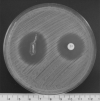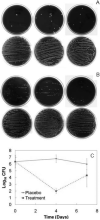The effectiveness of the controlled release of gentamicin from polyelectrolyte multilayers in the treatment of Staphylococcus aureus infection in a rabbit bone model
- PMID: 20488534
- PMCID: PMC2913156
- DOI: 10.1016/j.biomaterials.2010.04.011
The effectiveness of the controlled release of gentamicin from polyelectrolyte multilayers in the treatment of Staphylococcus aureus infection in a rabbit bone model
Abstract
While the infection rate of orthopedic implants is low, the required treatment, which can involve six weeks of antibiotic therapy and two additional surgical operations, is life threatening and expensive, and thus motivates the development of a one-stage re-implantation procedure. Polyelectrolyte multilayers incorporating gentamicin were fabricated using the layer-by-layer deposition process for use as a device coating to address an existing bone infection in a direct implant exchange operation. The films eluted about 70% of their payload in vitro during the first three days and subsequently continued to release drug for more than four additional weeks, reaching a total average release of over 550 microg/cm(2). The coatings were demonstrated to be bactericidal against Staphylococcus aureus, and degradation products were generally nontoxic towards MC3T3-E1 murine preosteoblasts. Film-coated titanium implants were compared to uncoated implants in an in vivo S. aureus bone infection model. After a direct exchange procedure, the antimicrobial-coated devices yielded bone homogenates with a significantly lower degree of infection than uncoated devices at both day four (p < 0.004) and day seven (p < 0.03). This study has demonstrated that a self-assembled ultrathin film coating is capable of effectively treating an experimental bone infection in vivo and lays the foundation for development of a multi-therapeutic film for optimized, synergistic treatment of pain, infection, and osteomyelitis.
Copyright 2010 Elsevier Ltd. All rights reserved.
Figures








References
-
- Lew DP, Waldvogel FA. Osteomyelitis. Lancet. 2004;364(9431):369–379. - PubMed
-
- Soundrapandian C, Datta S, Sa B. Drug-eluting implants for osteomyelitis. Crit Rev Ther Drug. 2007;24(6):493–545. - PubMed
-
- Fisman DN, Reilly DT, Karchmer AW, Goldie SJ. Clinical effectiveness and cost-effectiveness of 2 management strategies for infected total hip arthroplasty in the elderly. Clin Infect Dis. 2001;32(3):419–430. - PubMed
-
- Andrews JM. Determination of minimum inhibitory concentrations. J Antimicrob Chemoth. 2001;48:5–16. - PubMed
-
- Buchholz HW, Elson RA, Heinert K. Antibiotic-loaded acrylic cement - Current concepts. Clin Orthop Relat R. 1984;(190):96–108. - PubMed
Publication types
MeSH terms
Substances
Grants and funding
LinkOut - more resources
Full Text Sources
Other Literature Sources
Medical

